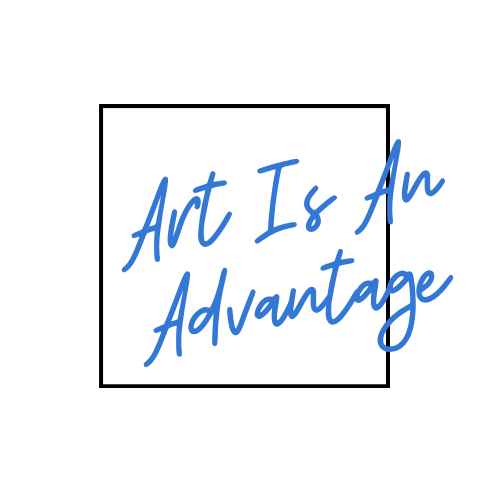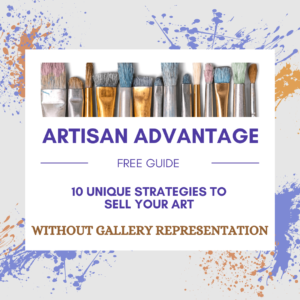
by Rebecca Sciullo | Dec 11, 2023 | Channels
Elevating Your Social Media Presence as an Artist
Last week, we posted twelve ideas to use on your artist blog to connect with your audience, showcase your work, and share your artistic journey. Another key part of your marketing system is using social media channels.
Like blogging, you may need some ideas to help with your social media content, especially when getting outside the routine of simply posting images of your work. However, breaking away from the routine of posting artwork images alone can be challenging. Here are some content types and how you might use them in your art business

1 – Short-Form Video
Short-form videos are concise, engaging visual content typically lasting between 15 seconds to a few minutes. Short-form content allows you to share snippets of your work, from quick tutorials demonstrating artistic techniques to time-lapse videos capturing the creation process.
Highlight completed pieces, offer glimpses into your studio routine, or tell the story behind a piece of art.
2 – Long-Form Video
Long-form videos use content with extended durations, often ranging from several minutes to hours. This format offers a deeper dive into your creative process, allowing comprehensive tutorials, in-depth documentaries, or detailed artist talks. Use long-form videos to demonstrate techniques, share personal narratives, or conduct workshops, providing valuable insights and fostering a strong connection with viewers.
3 – User-Generated Content
User-generated content (UGC) refers to any form of content—text, images, videos, reviews—created by your audience rather than you. Encourage followers to share creations inspired by your work or participate in art challenges. Are you a teaching artist? Encourage your followers and students to share their creations inspired by your teaching. Or, ask collectors to post your work hanging in their spaces. Showcase this content on social media profiles or websites, fostering community engagement and collaboration.
4 – Live Stream
A live stream is a real-time broadcast transmitted over the internet, allowing viewers to watch events or content unfold as it happens. Use live streams to interact directly with your audience, showcase your creative process, host Q&A sessions, conduct live art demonstrations, or unveil new work. This medium offers an intimate and immediate connection, enabling you to engage in real-time conversations, receive instant feedback, and cultivate community.
5 – Polls and Questions
Polls and questions are interactive features on social media platforms that engage users by soliciting their opinions or prompting responses. Leverage these tools by seeking input on upcoming projects, asking followers about preferred artistic themes, or conducting polls to determine the next art piece to create. Engaging audiences with questions about their artistic preferences, favorite colors, or styles fosters interaction and helps you tailor content to suit your audience’s interests.
6 – Contests or Giveaways
Use contests or giveaways on social media to boost engagement and expand your audience reach. Encourage user participation by hosting contests or giveaways, such as sharing your content to enter the contest. Offering art pieces or exclusive experiences as prizes incentivizes involvement, fostering a sense of community and appreciation among followers while increasing your online presence and attracting new audiences to their work.
Consistency is Key
These different content types break the monotony of traditional art posts and allow you to establish a deeper connection with your audience.
Remember, the key lies in experimentation and consistency. Discover what resonates best with your audience and refine your approach accordingly. Embrace the versatility of social media platforms to tell your unique story as an artist, and watch as your online presence grows.
Get More Ideas for Your Art Business
Want more ideas and help for your art business? Join the Artisan Advantage weekly information drop here.
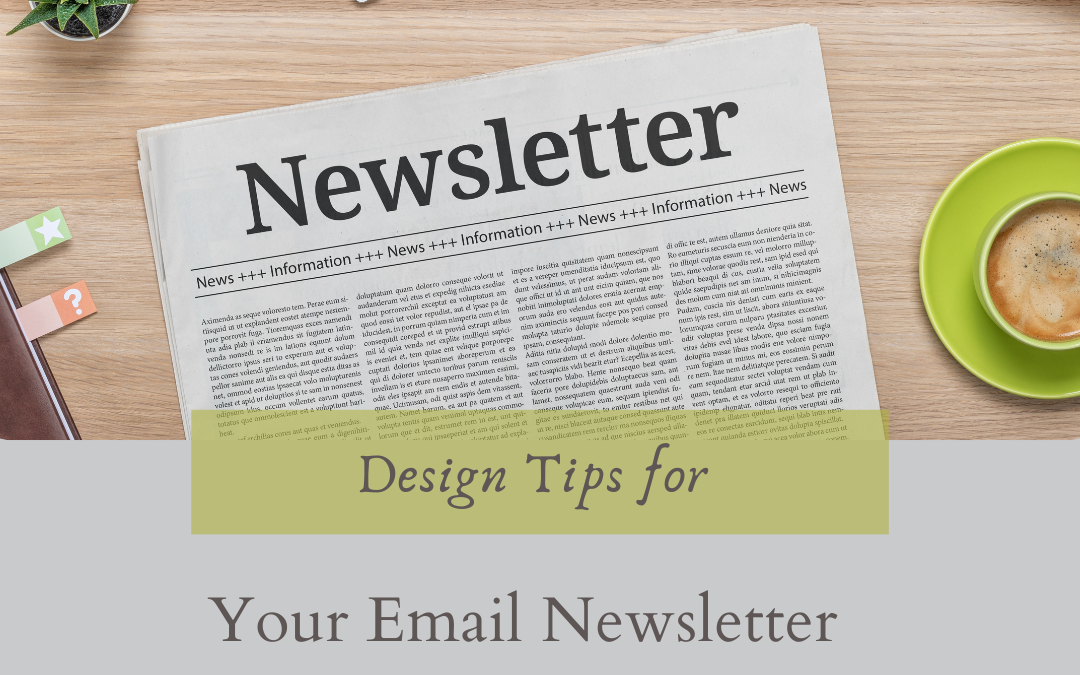
by Rebecca Sciullo | Nov 17, 2023 | Channels
Design tips for your artist newsletter’s template.
Now that we’ve covered the importance and how to set up a template for your email newsletters, it’s time to focus on the design. Designing an email newsletter template thoughtfully for your art business will showcase your creativity and engage your audience.
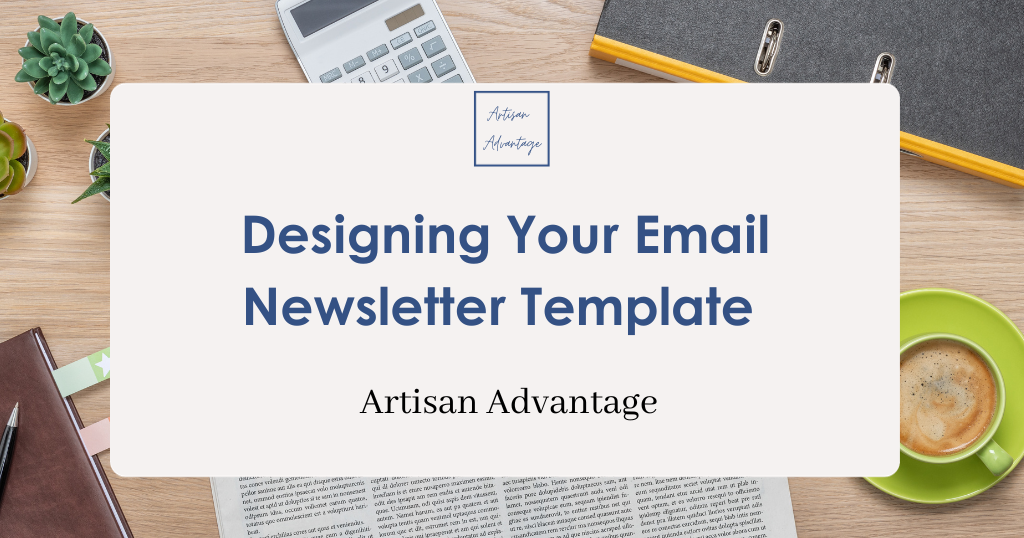
Here are some design tips to make your artist’s email newsletter visually appealing and effective:
Use an Eye-Catching Header
Start with a visually striking header that includes your business logo or a representative image of your artwork. Use a consistent color palette that aligns with your brand.
Set up a Clean Layout
Keep the layout clean and organized to make it easy for subscribers to navigate.
Using grids or sections, separate different types of content, such as featured artworks, updates, and calls to action.
Use High-Quality Images
Showcase your art with high-quality images. Use clear, well-lit photos that highlight the details of your work.
Use Branded Fonts
Choose fonts that align with your brand identity. Use a maximum of two or three fonts for consistency.
Ensure the text is legible and easily read, even on mobile devices.
Incorporate Engaging Colors
Integrate colors that reflect the mood and style of your artwork. Consistent color choices contribute to a cohesive brand image.
Experiment with contrasting colors to make essential elements, like call-to-action buttons, stand out.
Embrace Whitespace
Embrace whitespace to avoid a cluttered look. Whitespace helps your subscribers focus on your content without feeling overwhelmed.
Use padding and margins effectively to create a balanced design.
Make Sure You Use a Responsive Design
Ensure your email template is mobile-friendly. Many users check emails on their phones, so a responsive design is crucial for a positive user experience.
Add a Personal Touch
To add a personal touch to your newsletter, consider including a short artist’s note, behind-the-scenes glimpses, or anecdotes about your creative process.
Maintain Consistent Branding
Maintain a consistent look and feel across all your emails, building brand recognition and trust with your audience.
Use a Clear Call-to-Action (CTA)
Place a clear and compelling CTA button directing subscribers to your website, online store, or event. Use action-oriented language to encourage engagement.
Pulling it Together
Remember, creating a visually appealing and cohesive design that reflects your artistic style while effectively communicating with your audience is key. Feel free to experiment and tailor these tips to suit the unique personality of your art business.
Get Art Marketing Tips Delivered Weekly to Your Inbox
Join my weekly art marketing info drop here to get more assistance like this for your art business delivered to your inbox every week.
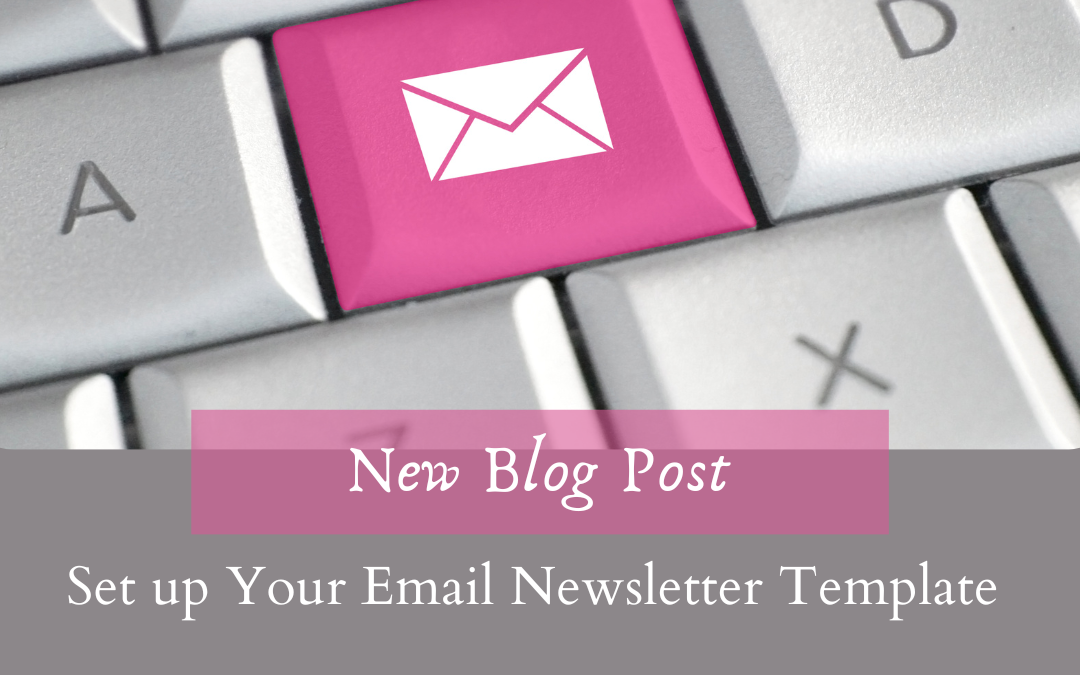
by Rebecca Sciullo | Nov 9, 2023 | Channels
Streamline Your Email Marketing – Set up A Template for Your Email Newsletter
When it comes to making your art business work, efficiency is key. One effective way to streamline your email marketing efforts is by setting up email templates. These templates save you time and ensure consistency in your branding and messaging. Here’s a step-by-step guide on how to create and set up email templates:
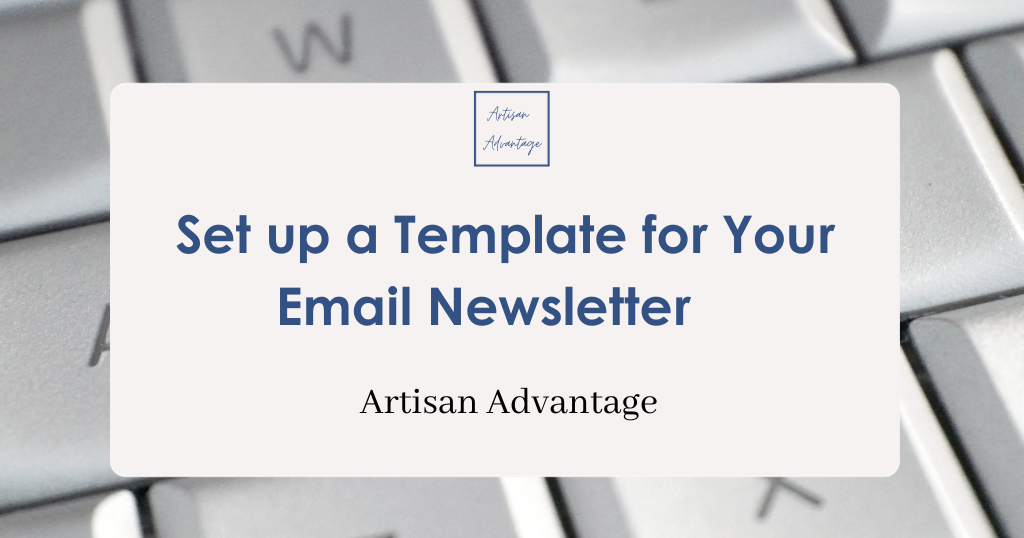
How to Set up a Template to Use in Your Art Businesses’ Email Marketing System
1 – Choose Your Email Marketing Platform
Start by selecting an email marketing platform that suits your needs. Popular options include Mailchimp, Constant Contact, and MailerLite.
2 – Access Template Options
Once logged into your chosen platform, navigate to the email template section. Most offer a variety of pre-designed templates or a blank canvas to start from scratch.
3 – Design Your Template
Customize your template to match your art style and aesthetics. Add your logo or name, choose a color scheme, and choose fonts that align with your brand identity. Make sure that your template is mobile-responsive for an easy user experience.
4 – Content Blocks
Divide your template into content blocks. Standard blocks include headers, subheadings, text, images, buttons, and footers. Arrange these blocks to create an appealing and coherent layout.
5 – Placeholder Text and Images
Use placeholder text and images to make it easier to swap in actual content for each email. This process saves time when creating new campaigns.
6 – Personalization
Many email marketing platforms let you personalize emails with recipient names or other dynamic content. Incorporate these elements into your template for a more engaging user experience.
7 – Testing
Before saving your template, test it to ensure everything looks and functions as intended across different devices and email clients.
8 – Save and Use
Once you’re satisfied with your template, save it for future use. The next time you create an email campaign, select your template as a starting point and you’ll be well on your way to crafting professional, on-brand emails in no time.
Incorporating email templates into your email marketing strategy is a smart move that will save you time, maintain consistency and enhance the overall impact of your email campaigns. So, set up those templates to keep your art marketing emails flowing.
Want to. Learn More?
Next week, I’ll post about design tips for your email newsletter.
Would you like more information to help with your art business AND invitations to free art marketing events? Join my weekly email newsletter here.
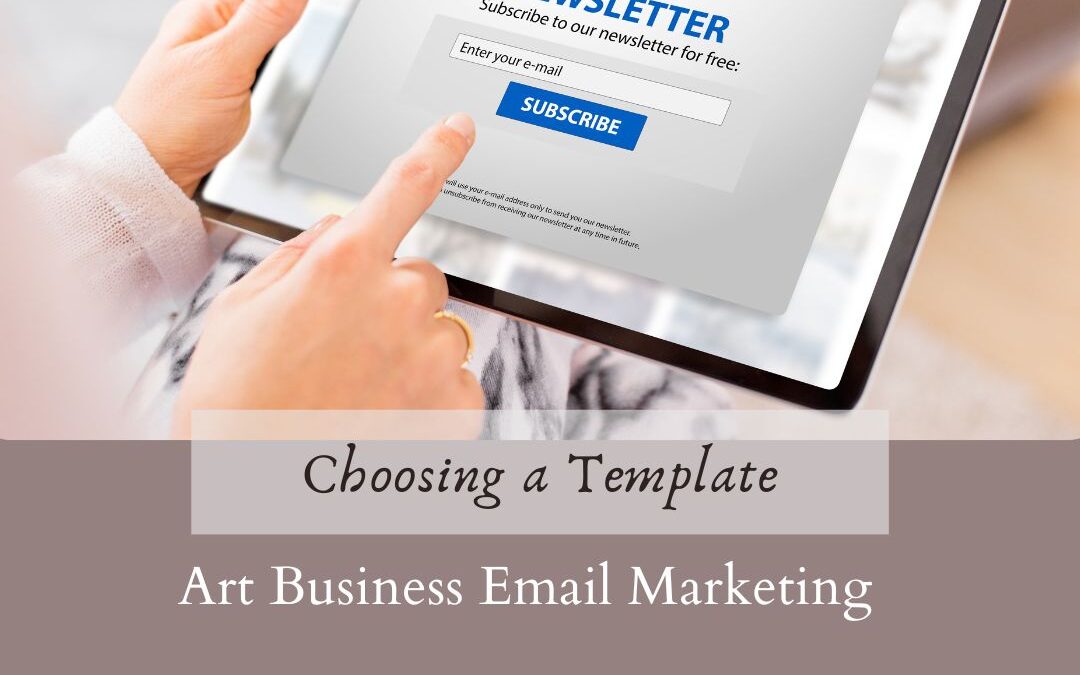
by Rebecca Sciullo | Sep 18, 2023 | Channels
How to Choose the Perfect Email Newsletter Template for Your Art Business
Email newsletters are invaluable for you to connect with your audience. When setting up your email marketing system, choosing and using a consistent template for you to use each time you send a message, makes it easier to communicate effectively on a consistent basis.
Set up your email marketing system.
If you subscribe to my weekly newsletter, you might notice that it looks consistent from week to week. This is because I have a simple pre-designed template that I use to create my messages. I use the same header and information is presented in the same format each time I send a message. This system allows me to easily create my messages, without having to recreate the wheel.
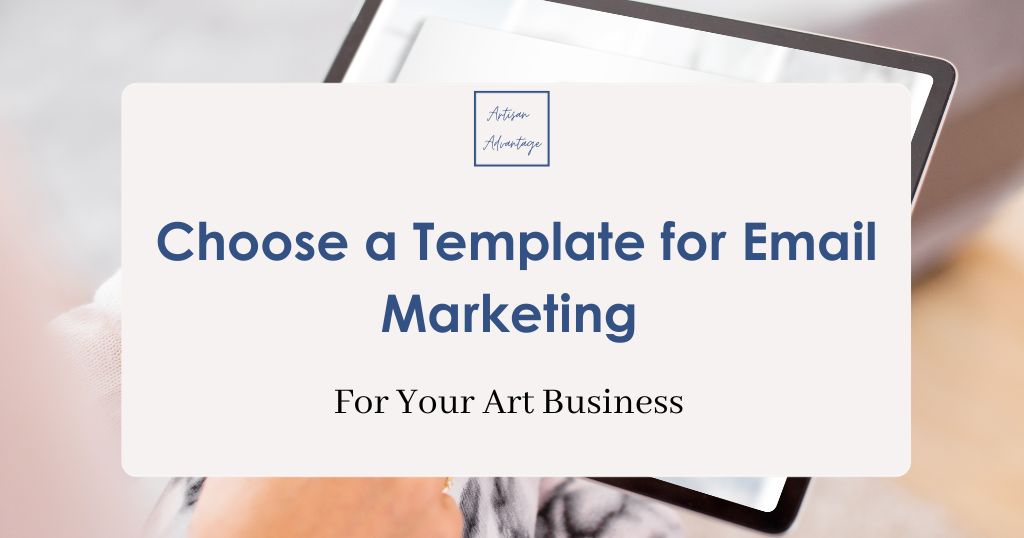
What’s a Template?
A template in email marketing is a pre-designed layout or structure for creating email campaigns. It includes placeholders for text, images, links, and other elements.
Using a template helps to maintain a consistent and professional look for your messages. Templates will also save you time and ensure consistency across your campaigns. They are customizable, allowing for the insertion of unique content while adhering to the established design, which enhances brand recognition and the overall effectiveness of your email marketing efforts.
But with countless options available, how do you choose the best template for your art business? Here’s a guide to help you navigate the process.
How to Choose Your Email Template
Know Your Artistic Brand Identity
Your email newsletter should reflect your unique brand identity. Choose one that aligns with your colors, style, and aesthetics. Consistency is key to building recognition and trust among your readers.
Consider Layout and Content
Different templates offer varying layouts for content placement. Think about the content you’ll be sharing—new art, blog posts, or event updates—and select a template that presents your content in an engaging and organized manner.
Mobile Responsiveness:
Choose a mobile-friendly design for today’s mobile-centric world.
Visual Appeal
Look for templates that allow you to showcase your artwork, photography, or visuals prominently.
Customizability
While templates offer a starting point, the ability to customize is crucial. Choose a template that allows you to tweak colors, fonts, and layouts to make it your own.
Call-to-Action
Whether selling art, promoting an event, or sharing a blog post, ensure your chosen template provides ample space for clear and compelling calls to action.
How to set up your template.
In a couple of weeks, I’ll post the steps to choosing and setting up your template in your email marketing platform. Join my weekly newsletter here so you won’t miss the post.
More Resources
Want to learn more about email marketing for an artist ? You might like Building an Email List for Your Art Business.
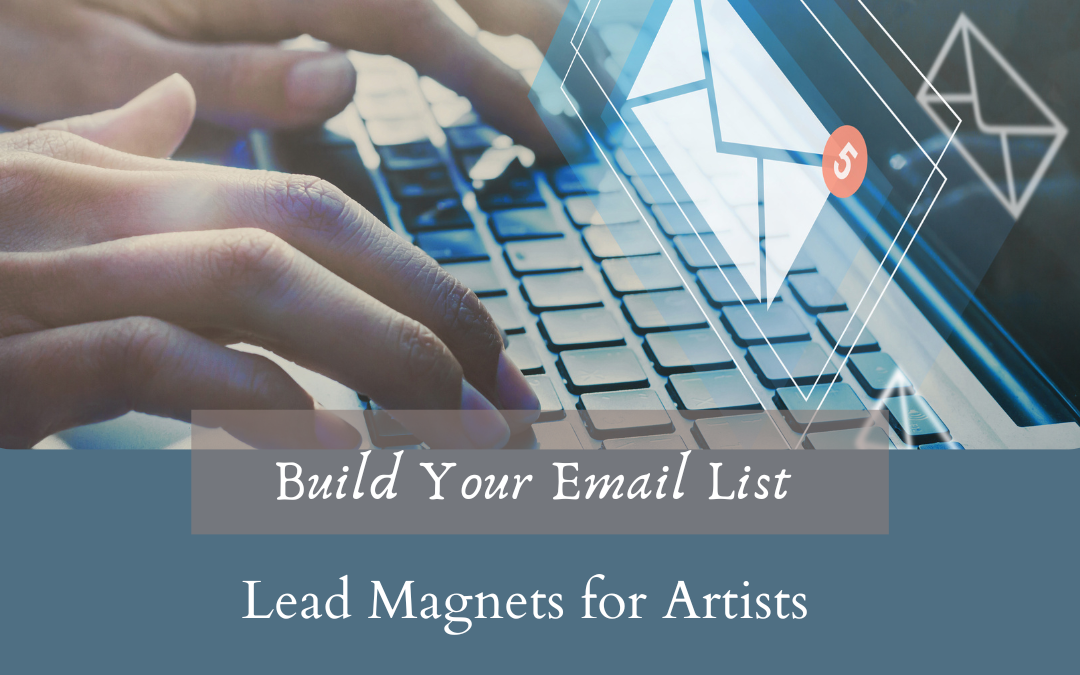
by Rebecca Sciullo | Sep 8, 2023 | Channels
Grow an Email List for Your Art Business with a Lead Magnet
Building a solid connection with your audience is critical to growing your art business. The best way to communicate with your contacts regularly is through regular email communication. But how do you gather emails and encourage people to subscribe to your list? One effective way to engage your audience and expand your reach is by offering lead magnets – incentives encouraging people to join your email list. Effective lead magnets help you capture potential fans, allowing you to nurture relationships and make sales.
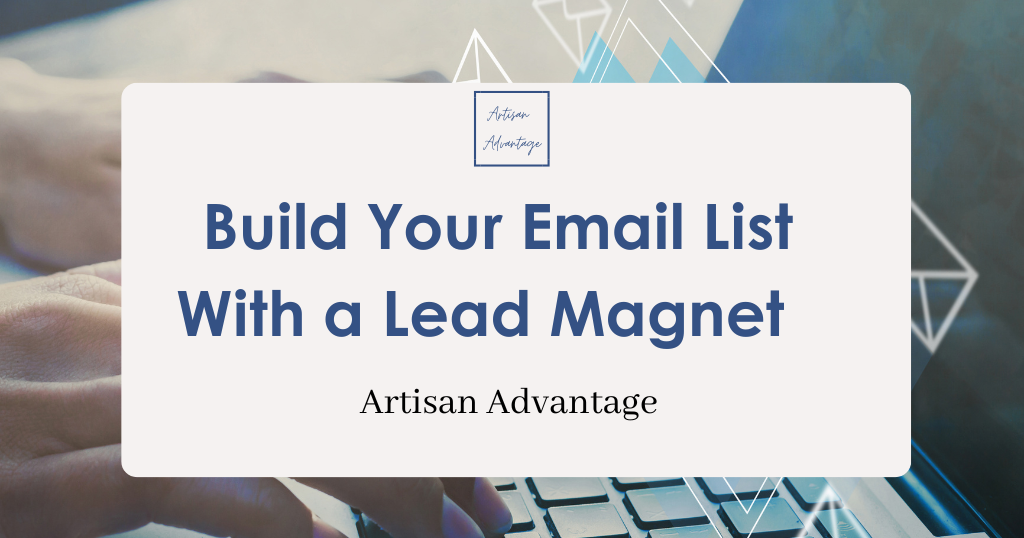
Six Lead Magnet Ideas for Artists
Remember, not all of these will be appropriate for your business. What works for one artist might seem silly or irrelevant to another. Use ideas that make sense for you and your audience.
1 – Exclusive Art Tutorials
Are you a teaching artist? Share your artistic expertise by offering a free tutorial video or downloadable guide showcasing your unique techniques. Whether it’s painting, digital illustration, or sculpture, providing a sneak peek into your creative process can enthrall aspiring artists and enthusiasts.
2 – Printable Artwork
Craft a beautiful digital print of one of your creations that users can print and display. This introduces your art to their spaces and serves as a visual reminder of your talents.
3 – Behind-the-Scenes Content
Invite your audience into your studio or workspace with behind-the-scenes glimpses of your creative process. People love seeing the “making of” your art.
4 – Art Guide or Talk
Create a guide your target audience might find helpful. For example, you could create a guide about how engaging with art can be a form of relaxation or inspiration. Or, put together a guide for art lovers in your local area of lesser-known art museums and venues.
You could also record an artist talk or tour of your studio as a special incentive.
5 – Art-Inspired Playlist
Compile a playlist of music that fuels your creative process. Music and art often go hand in hand, and sharing your playlist can help your audience connect with your inspirations on a deeper level.
6 – Early Access and Discounts
Offer early access to upcoming art collections or exclusive discounts for subscribers. This rewards your most engaged fans and encourages them to stay connected for your latest updates.
Remember, the key to a successful lead magnet is to offer something genuinely valuable that aligns with your art and your audience. When promoting your lead magnet, use your social media platforms, website, and collaborations with fellow artists to reach a wider audience.
Maintain a Consistent Email Marketing Strategy
Lastly, while creating lead magnets are one piece of the puzzle, it’s crucial to maintain a consistent email marketing strategy to nurture your newfound relationships. Deliver relevant content, engage in conversations, and provide updates on your art and accomplishments, Combining compelling lead magnets with consistent engagement will transform casual followers into dedicated fans anticipating your next creation.
In the ever-evolving landscape of artistic expression, strategically using lead magnets can help you grow your list of dedicated fans and followers, ultimately increasing sales and growing your business.
Stay connected
Would you like more information about marketing your art? Get my weekly information drop here.
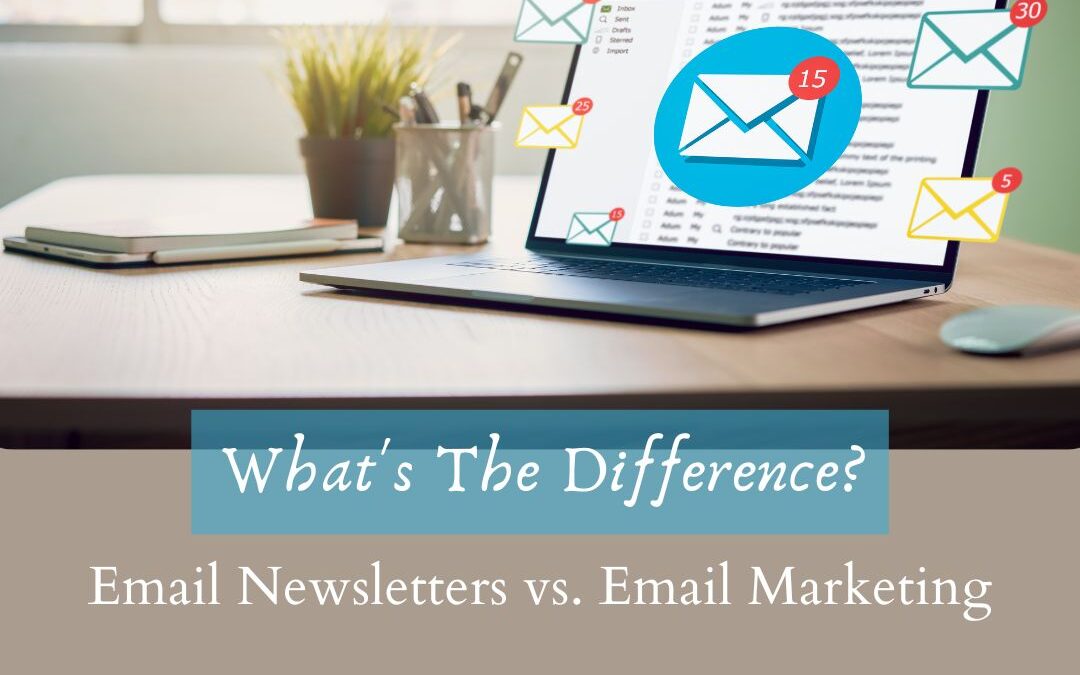
by Rebecca Sciullo | Aug 16, 2023 | Channels
Email Marketing and Email Newsletters Serve Different Purposes in Your Business
In art marketing, strategies like email marketing and email newsletters play a vital role in building your brand and engaging your fans. While these terms might sound similar, they serve distinct purposes that can significantly impact your artistic journey. Let’s dive into the nuances of each and discover how they can elevate your art marketing game.
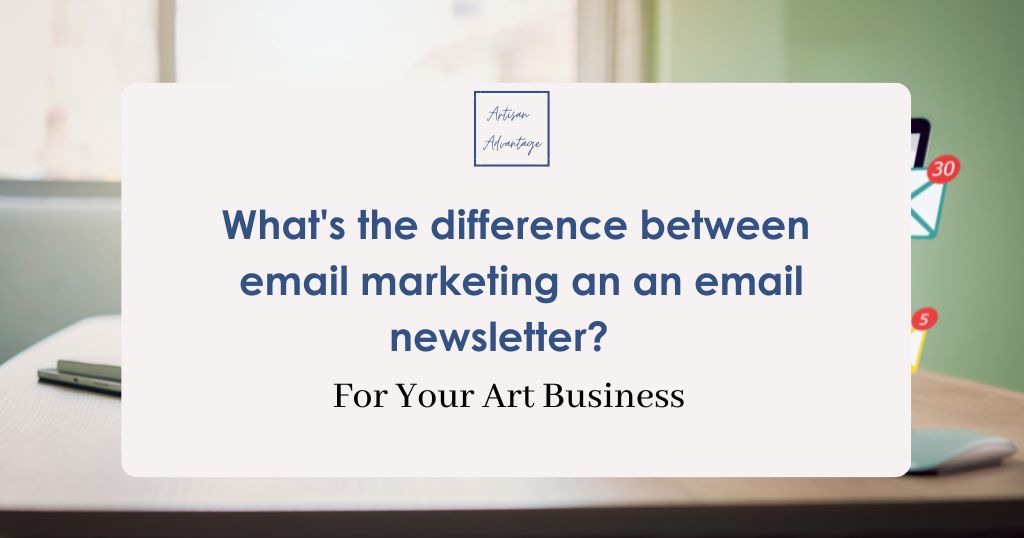
Email Marketing: Crafting Compelling Promotions
As an artist, showcasing your work is essential to gaining recognition and generating sales. This is where email marketing plays a role, sending promotional messages, advertisements, or offers directly to a list of subscribers. The primary objective here is to encourage recipients to take action – such as purchasing your artwork, signing up for art classes, or attending your exhibitions.
Let’s say you’ve just completed a new collection of work. With an email marketing campaign, you can create a visually captivating email that showcases your artwork and provides details about an upcoming gallery exhibit. The message would include a clear call to action, inviting subscribers to attend the opening reception and be the first to see your work. Email marketing can be a powerful tool to drive sales and promote your artistic endeavors by strategically targeting your audience and tailoring your message.
Your Email Newsletter: Forging Lasting Connections
While email marketing aims to make a sale, email newsletters are about building relationships and fostering a sense of community with your audience. As an artist, your subscribers aren’t just customers but admirers and supporters of your creative vision. An email newsletter is your canvas for delivering valuable, relevant content that resonates with your subscribers.
Imagine sending out a regular newsletter that delves into your artistic process, shares insights into your inspiration, and provides tips for aspiring artists. This approach allows you to connect deeper, creating a bond beyond the transactional. You can also highlight industry news, spotlight fellow artists, or share stories from your artistic journey. While promotional content can still be sprinkled in, the main goal of an email newsletter is to captivate and engage your subscribers through meaningful content.
Both Strategies Work Together
Both email marketing and email newsletters play unique yet complementary roles in your business. By integrating these strategies, you can create a well-rounded approach catering to your audience’s needs. Use email marketing to announce new artwork releases, special discounts, or upcoming events that require immediate action. Meanwhile, your email newsletter can offer a steady stream of inspiration, education, and storytelling to keep your subscribers connected and invested in your artistic journey.
In a world where digital communication is necessary, mastering the art of art marketing is essential for any creative entrepreneur. Remember, email marketing gets the spotlight shining on your offers, while email newsletters set the stage for building a lasting artistic connection. So, brush up on your email marketing skills, refine your newsletter content, and watch your fan base and business grow.
By expertly balancing these strategies, you’ll keep people appropriately informed about new art and events and deliver enjoyable content to people wanting to hear from you.
Was this information helpful to you?
If so, consider sharing it with another artist. Or, sign up for my weekly information drop to get more resources and art marketing tips.
Get an Email Marketing Checklist
Want to get started using email in your art business? Get my Email Marketing Checklist here.
You also might like these related posts
Building an Email List for Your Art Business
How to Choose an Email Service to Market Your Art

